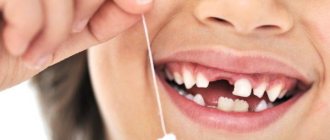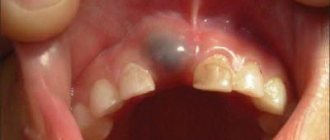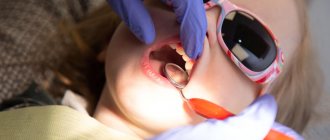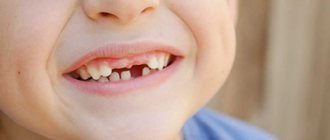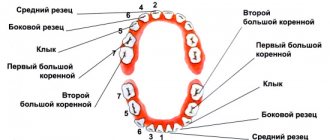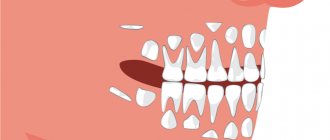Many of us remember from school that adults have 32 teeth, 16 of which are located both at the top and bottom of the oral cavity. You can often hear this information in advertising on television. But not everyone knows at what period teeth should erupt or how the absence of, say, wisdom teeth affects our body.
Every person, especially young parents, needs to know well how many baby teeth there are, when the molars appear, and what they are used for. All this information is needed to combat diseases of the oral cavity and the human body as a whole.
Anatomy of permanent teeth
Each molar consists of certain parts:
- crown. This is the part of the tooth that protrudes from the top;
- the root, it goes deep into the alveoli. At the same time, it is attached thanks to special connective tissue bundles. There can be different numbers of roots (1-5 pieces). This moment affects the number of nerves and channels;
- neck. This part is located between the root and the crown.
Tooth tissues are distinguished by their heterogeneity. The enamel is on top and is known for its durability. Once the tooth has erupted, it is covered with a transparent thin layer. This is the cuticle, which eventually changes to the pellicle. The latter is a film that is created from what saliva produces.
Beneath the enamel is dentin, the tissue of the tooth. Dentin is similar to bone when you study how it is built. However, it is more durable because there is a high level of mineralization. In the area where the root is located, the dental tissue is covered with cement. The latter is rich in mineral compounds and is also associated with periodontium. Collagen fibers are used for this.
As for the part of the tooth that is inside, this is the crown and root canal. They are filled with pulp. This is loose connective tissue; it contains nerve endings and blood vessels.
At what age do they appear?
Statistics show that the beginning and completion of the change from temporary teeth to molars in most children occurs at approximately the same time. There are minimal differences only among children in different regions. The warmer the climate, the sooner the child will have permanent teeth.
The table shows age parameters that can be used to determine the approximate beginning of the eruption of molars according to several well-known authors.
| Set of teeth | Period of eruption of permanent teeth in children (in years) | ||
| according to Vinogradova | according to Lukomsky | according to Novak | |
| Central incisors | 5-6 | 6-9 | 6-9 |
| Lateral incisors | 7-9 | 7-10 | 7-10 |
| Fangs | 12-13 | 9-14 | 9-14 |
| First premolars | 9-11 | 9-13 | 9-13 |
| Second premolars | 9-11 | 9-15 | 10-14 |
| First molars | 4,5-7 | 7-8 | 5-8 |
| Second molars | 12-13 | 10-15 | 10-14 |
| Third molars | 18-25 | 15-24 | 18-20 |
The differences in the age at which permanent teeth appear depending on the author are due to the fact that they present the results of studies in different regions that were carried out with a serious difference in time (several decades).
Differences between baby teeth and permanent teeth
Permanent and temporary teeth are built in the same way, but still have certain differences between themselves:
- The enamel on baby teeth is whiter. And the enamel on permanent teeth has a yellowish tint;
- the best indicators of density and mineralization are noted behind the molars;
- the pulp of a baby tooth is large in size, and the dense tissues and their walls are thinner;
- permanent teeth are larger in size, here the length is greater than the width;
- The root of baby teeth is short and thin compared to permanent teeth. When the root of temporary teeth is formed, they expand in width. Therefore, the permanent bud has free space to grow.
Possible dental problems
Parents of mature toddlers, in addition to the number of teeth at three years old, are also concerned about other dental problems. They are identified independently at home, at the next appointment with the dentist. List common deviations from standards.
The child has dark tooth enamel, yellowish molars
The cause of discoloration is poor cleaning, ignoring the rules of oral hygiene, taking iron-containing medications, and diseases of the internal organs.
Carious spots on teeth
Most adults are greatly mistaken if they believe that baby teeth do not need to be treated for caries. Pathogenic bacteria infect dental tissue, settle in the oral cavity for a long time, and subsequently destroy molars. The tooth begins to turn black from the central part, sometimes large black spots of different sizes appear on the enamel.
To avoid caries on baby teeth, you need to accustom your baby to daily hygiene and consume sufficient amounts of vitamins and minerals in food.
Periodontitis
When the tissue around the tooth becomes inflamed or the integrity of the cortical plate is compromised, the child’s gums become swollen, the cheeks increase in size, and the baby experiences constant aching pain. The cause of the disease is advanced caries and fungal infections.
At the age of 8-10 years, dentists are forced to remove a molar tooth for children with periodontitis, since the tissue changes are already irreversible.
It is important to pay attention to this problem during the period when it is possible to treat inflamed elements of the jaw.
Pulpitis
The nutrition of the hard tissues of the incisors is disrupted. The pulp is located inside the dental canal and consists of a nerve, a vessel, and connective cells. Destruction of the structure of this part of the molar leads to tissue starvation, death, and the incisors will crumble. Pulpitis affects not only the erupted tooth, but its rudiments.
Hypoplasia of tooth enamel
Molars become thinner, easily ground down and worn out. The pathology is genetic in nature and develops in utero.
Malocclusion
The teeth of the opposite rows do not close together due to prolonged sucking of a pacifier, heredity, bad habits: holding a finger in the mouth, gnawing on toys, etc.
Where do teeth come from?
Teeth begin to form and develop when the fetus is still inside the womb (at about 6 weeks). They have their source - the epithelial dental plate. Already by 14 weeks, active formation of dental tissues, which are hard, occurs. Initially, this occurs in the area where the crown will be, and later at the root.
Molars, namely their first rudiments, appear by the 5th month of the embryo. They are located higher than the child’s baby teeth or lower. By the time the child is born, the rudiments are already practically formed in the tissues of the jaw.
Teeth that belong to an additional group (have no predecessors) are formed later. This occurs after about 1 year of life. Why? Because the baby's jaw is still very small and there is not enough space for them.
How many teeth should a child have per year?
During this period, baby teeth begin to cut.
They begin to break out in the following sequence on the upper and lower jaws. On the top:
- 8-12 months. Central incisors.
- 9-13 months. Lateral incisors.
- 16-22 months. Fangs.
- 13-19 months. First molars.
- 25-33 months. Second molars.
In the lower jaw, this process is distributed in time somewhat differently:
- 6-10 months. Central incisors.
- 10-16 months. Lateral incisors.
- 17-23 months. Fangs.
- 14-18 months. First molars.
- 23-31 months. Second molars.
It is worth noting that these time limits are averaged and deviations up or down by 1-3 months are considered normal.
If you want to know how many teeth a child has per year is considered normal, you should refer to the chart described above. You get that at the age of 12 months there should be 6-8 of them.
What does a dental formula look like?
To make it more convenient to describe teeth and their number, special formulas are usually used. Each tooth has its own number, which is used to decipher its location.
When describing a milk bite, Roman numerals are used:
- incisors – I, II;
- canine – III;
- molars – IV, V.
If we talk about the formula for adult teeth, here the teeth are counted starting from the center:
- incisors – 1.2;
- fang – 3;
- molars (small) – 4.5;
- molars (large) – 6,7,8.
8 is a wisdom tooth; not every person has it.
Scheme - schedule for changing teeth in children:
- The central incisors are subject to renewal at the age of about 5 or 7 years, soon followed by the lateral ones.
- From 9 to 11 years the first molars are expected.
- At the same time as the molars, the canines also change.
- In the period of 10-13 years, the second molars also emerge.
By the age of 13, a teenager’s mouth can already count about 28 teeth. If there is a one-year delay in their appearance, it is recommended to consult a dentist. An adult must have at least 28 or 32 teeth. It must be remembered that from the age of five there begins a period of replacement of milk teeth with those that will be with a person throughout his life.
Teething order
Typically, all children start teething at about the same time. Teeth emerge from the molar set at the age of 5, and it is the molars (large ones) that emerge. Then the diagram is as follows:
- Initially, the incisors on the lower jaw change, which are located in the center;
- then the central incisors appear on the upper jaw and the incisors on the sides on the lower jaw;
- at about 8-9 years old, the incisors on the top and sides change;
- up to 12 years of age, molars (small) grow;
- at the age of 13, the fangs change;
- after the child turns 14 years old, the second molars (large ones) come in. They were not included in the milk kit;
- and after another 1 year the third molars (large) appear. This is a wisdom tooth. But he may not appear at all.
Timing and order of teething
No specialist can say with accuracy what time babies start teething. However, it is generally accepted that the first lower central incisors should appear when the baby is 6 months old. All 20 baby teeth should be in the mouth by the age of 3 years.
It also happens that children’s upper teeth come in first and they appear much later than 6 months. This process is not considered by experts as a deviation from the norm, because teeth begin to erupt from the gums in the sequence in which they were laid during the prenatal period.
Thus, dentists do not recommend focusing attention on which teeth come out first in a child. Despite this, the following scheme for the appearance of incisors in children is generally accepted; parents can partially rely on it if they wish:
- The central ones erupt first, and only then the lateral lower and upper incisors;
- molars, canines and second molars erupt next;
- predominantly the lower teeth appear first, and then the upper ones;
- The appearance of incisors in pairs is often observed; two pairs may even erupt at once.
A common phenomenon is when teeth come out in the wrong order. What to do in such a situation? It is advisable to contact a pediatric dentist to rule out abnormalities. The fact is that deviations in the timing and sequence of teething in children can be caused by the following reasons:
- calcium deficiency and the development of rickets;
- thyroid diseases;
- dysfunction of the digestive system;
- absence of incisors in the gums.
As a rule, there is no cause for concern if the child is under one year old and has no teeth.
How to determine that a child will soon have molars?
There are certain signs that indicate that permanent teeth will soon begin to erupt:
- The spaces between the teeth increase. The jaw grows and the free space increases;
- baby teeth become loose as the root gradually dissolves. It cannot be firmly fixed in the jaw tissues;
- in case of loss of a temporary tooth. This confirms that the molar will soon come out as it has pushed out the previous one;
- The gums are slightly swollen and red.
When permanent teeth erupt, the child’s general well-being usually remains the same, the temperature does not rise, and there is no pain.
Oral care
Going to the pediatric dentist with a swollen cheek and molars destroyed by caries is the worst option. It is better to prevent dental diseases by following the rules of oral care.
Follow these guidelines:
- Buy your daughter or son a beautiful toothbrush and tasty toothpaste without fluoride.
- Shop together to choose what your baby will definitely like.
- Apply the paste to the brush in a minimal amount, no more than a pea.
- Record the time for cleaning, spend at least 3 minutes on the procedure.
- Conduct preventative conversations about the benefits of oral hygiene.
- Tell a scary tale about dental monsters that destroy molars if you don't brush them before bed.
- Watch an educational cartoon together, read a fairy tale, or make up one yourself so that your child understands why his teeth hurt.
- Don't trust three-year-old toddlers to clean their mouths on their own. It is better to carry out a control procedure for several months.
- Treat the initial stages of caries with silvering.
This is a safe and beneficial procedure. It helps to avoid early removal of incisors, is used as a prevention of destruction, and replaces filling.
Possible problems
Permanent teeth have just appeared, but this does not mean that there will not immediately be any problems associated with them. Parents should be aware of possible dental problems:
- lack of molars;
- pain in the molar area;
- crooked position of molars;
- molars fall out;
- injuries.
For any of these problems, it is important to contact a specialist in time to receive qualified help.
How many teeth should a child have?
It all depends on age. The maximum number of teeth in the period from birth to 5-6 years is 20 - these are milk teeth. Then, until the age of 15-16, the molars begin to erupt, pushing out the milk teeth. Ultimately, their number grows to 28.
The latest are the third molars. They grow only after 18 years of age, but not everyone has them.
It is worth noting that the period of formation and eruption of baby teeth is very individual. In some children, all 20 teeth grow by the age of 2, while in others - by 2.5 or later. Such delays within a year are considered normal and are not a developmental anomaly.
If teeth do not start cutting in the first year of the baby’s life, you should consult a doctor to find out the reasons.
To the list of posts
What are baby teeth?
Milk teeth are the teeth that are the first to erupt in humans. Their rudiments are formed in the womb, at approximately 5-7 weeks of pregnancy, and by the age of three the child already has 20 teeth. Milk teeth differ from permanent teeth in structure (they are smaller and have a different shape), and the bite does not contain small molars, or premolars.
X-ray of baby teeth
